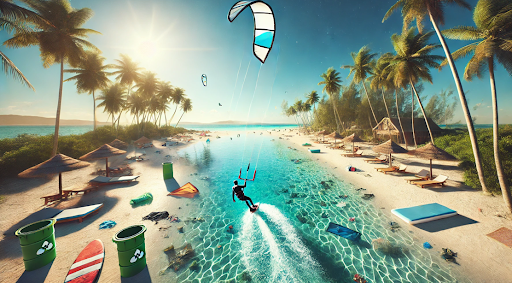Kitesurfing is a thrilling and dynamic sport, but it is also one that is heavily dependent on coastal weather conditions. The success of a kitesurfing session largely hinges on understanding and adapting to the wind, waves, and overall weather of coastal regions. While coastal areas offer some of the best conditions for kitesurfing, it’s crucial for both beginners and seasoned riders to know how to navigate weather patterns to make the most out of their experience.
Wind: The Lifeblood of Kitesurfing
Wind is the most important factor when it comes to kitesurfing. Without wind, kitesurfers cannot generate the power needed to ride across the water or perform tricks. Different wind conditions can have a significant impact on the experience, making it essential for kitesurfers to understand how to read and work with the wind.
In places like Egypt, the coastal winds are typically consistent, making the Red Sea a prime destination for kitesurfing. For those looking to get started, Learn kitesurfing in Egypt where the wind conditions are favorable for all skill levels.
Here are some key wind-related factors that kitesurfers should keep in mind:
- Wind Speed: Ideal wind speeds for kitesurfing usually range between 12 to 25 knots. Winds that are too light (under 10 knots) can make it difficult to generate enough power, while winds that are too strong (above 30 knots) can be dangerous for beginners.
- Wind Direction: The direction of the wind plays a crucial role in how you control your kite. Side-shore winds, which blow parallel to the beach, are the safest for kitesurfing. Onshore winds (blowing from the sea toward the shore) can push you into the beach, while offshore winds (blowing from the land toward the sea) can carry you too far from the shore, making them less ideal.
- Gusts: Gusty winds, which rapidly change speed and direction, can be challenging to navigate. These unpredictable wind conditions can make it harder to control your kite and are generally not recommended for beginners.
Temperature and Air Density
Coastal weather isn’t just about wind; temperature and air density also affect kitesurfing. Cold air is denser than warm air, which can generate more lift for the kite, giving you more power. This is why kitesurfing in cooler conditions can feel different than in warm climates.
For example, even though warm-weather destinations like Egypt may have milder air densities, the consistent winds make up for any lack of power that denser air might provide in colder locations. For those visiting warm-weather destinations, you can conveniently access Gear Rental in El Gouna to make sure you have the right equipment for the conditions.
Wave Height and Ocean Currents
Waves and currents are another key element of coastal weather that can greatly affect your kitesurfing experience. Flat, shallow waters are ideal for beginners who are still learning how to control their kites and maintain balance. On the other hand, advanced riders often seek out locations with bigger waves and stronger ocean currents to challenge themselves and perform tricks.
However, the wave conditions are largely influenced by the wind. In locations where the wind blows consistently in one direction, you’re likely to experience smaller, more manageable waves. But if the wind changes direction or strength frequently, you can expect larger and more unpredictable waves. Understanding wave forecasts can help you plan your sessions accordingly and choose the right spots based on your skill level.
Seasonal Changes
Coastal weather is prone to seasonal changes, and it’s important to take this into account when planning a kitesurfing trip. In some regions, the wind conditions may vary significantly depending on the time of year. For instance, the best time to kitesurf in Egypt’s Red Sea area is generally from April to October when the winds are most consistent.
Off-season months may still offer opportunities for kitesurfing, but you’ll need to keep a closer eye on wind patterns and weather forecasts. Many kitesurfing schools and resorts adjust their training programs and activities based on seasonal wind and wave patterns, so always check in advance.
Safety and Weather Hazards
Understanding coastal weather patterns is also critical for safety. Sudden weather changes, such as thunderstorms or high winds, can turn a fun kitesurfing session into a dangerous situation. It’s essential to stay updated on weather forecasts and be prepared to adjust your plans if the conditions turn hazardous.
Here are a few safety tips when dealing with coastal weather:
- Monitor Weather Reports: Always check the local weather forecast before heading out. Pay special attention to wind speeds and potential storm warnings.
- Know the Local Tides: Tidal changes can affect the size of waves and the depth of water. Understanding the local tides is important, especially for beginners who are practicing in shallow waters.
- Be Aware of Cloud Cover: Thick cloud cover can cause wind patterns to shift quickly. It’s always best to avoid kitesurfing when a storm is approaching.
Conclusion
Coastal weather plays a significant role in shaping the kitesurfing experience. From wind speed and direction to wave height and air density, understanding how different weather factors impact kitesurfing can make the difference between an enjoyable session and a challenging one.
Whether you’re a beginner learning the ropes or an experienced rider looking to master advanced techniques, having a grasp of how coastal weather works is essential to improving your skills and staying safe.
With consistent winds and favorable conditions, destinations like Egypt offer an excellent environment for kitesurfing year-round. So, the next time you plan your kitesurfing adventure, be sure to factor in the weather for the best possible experience.





